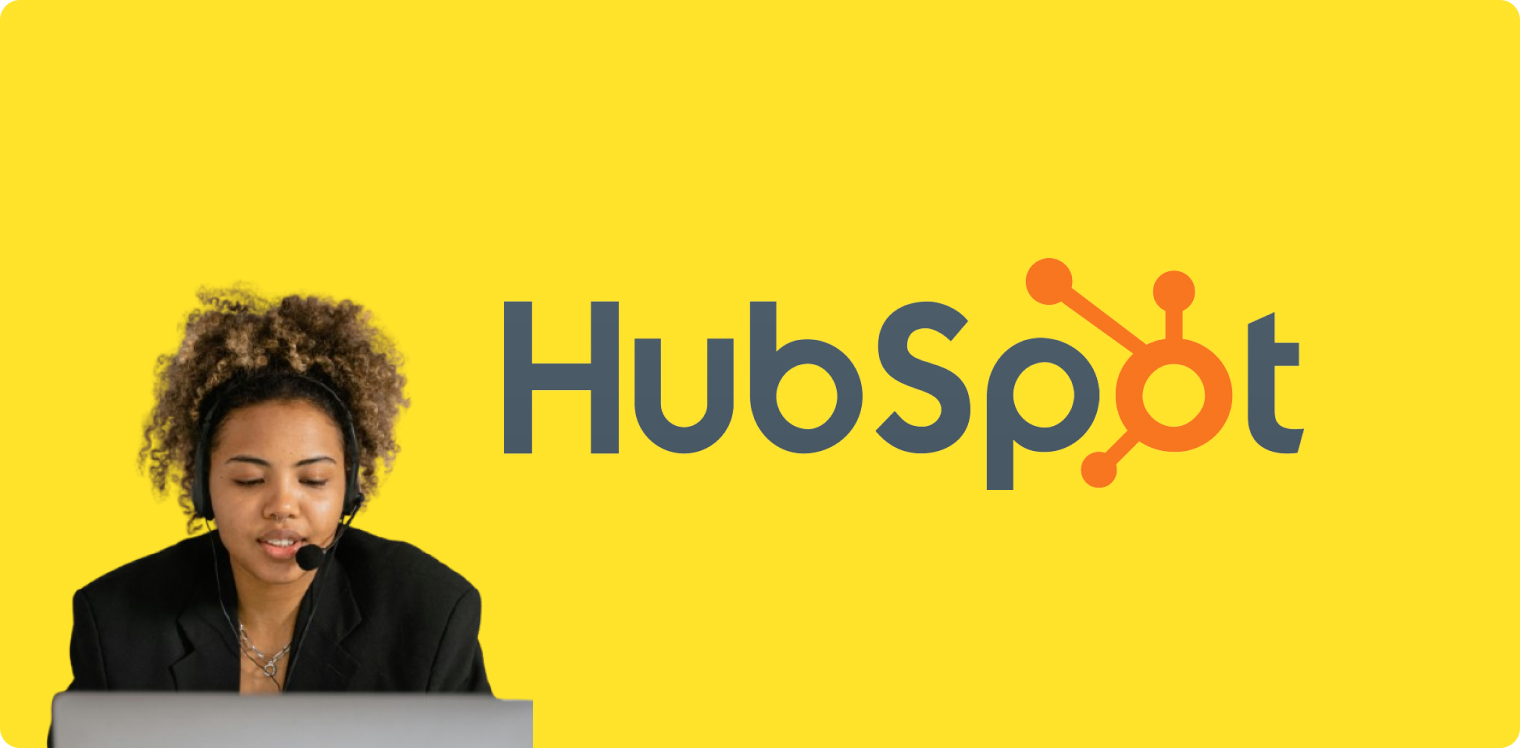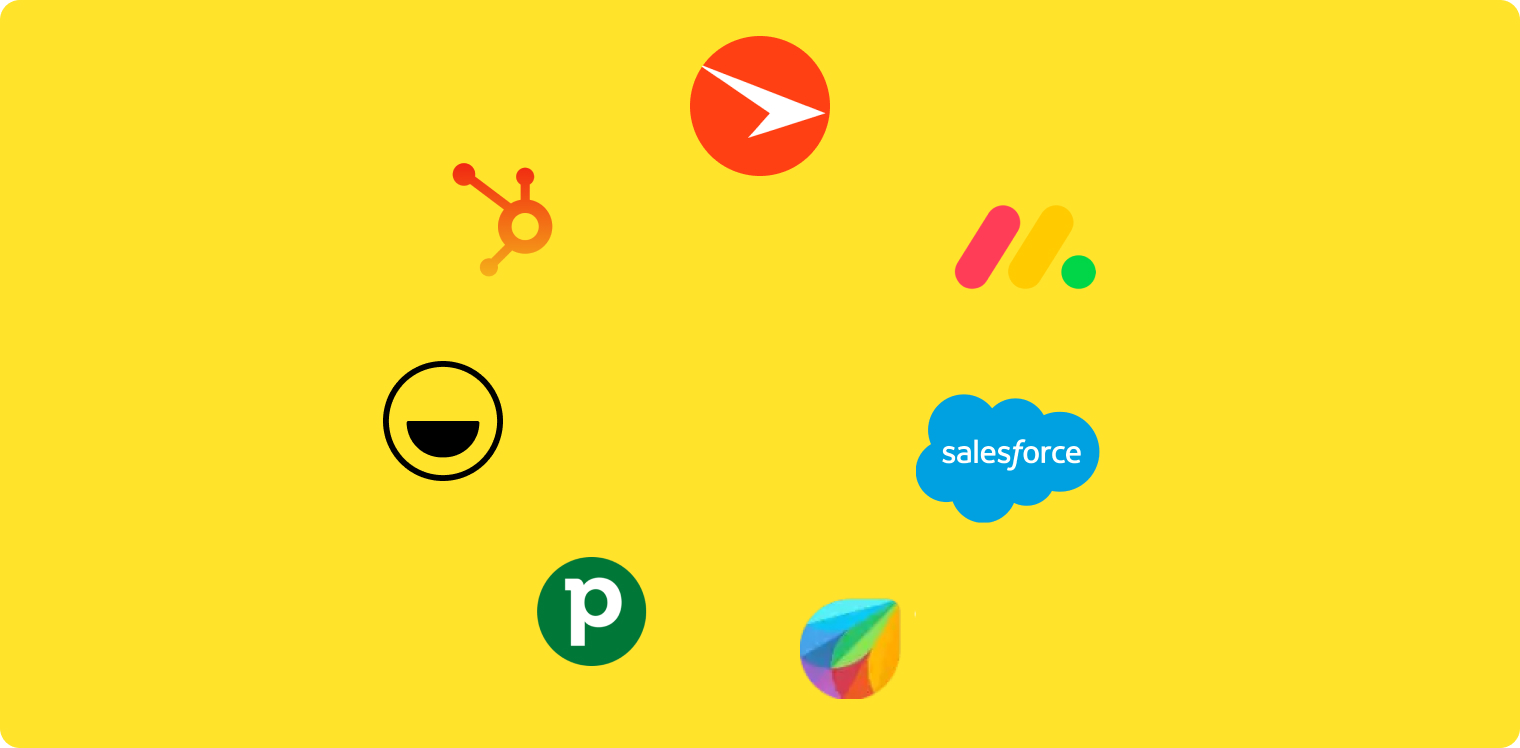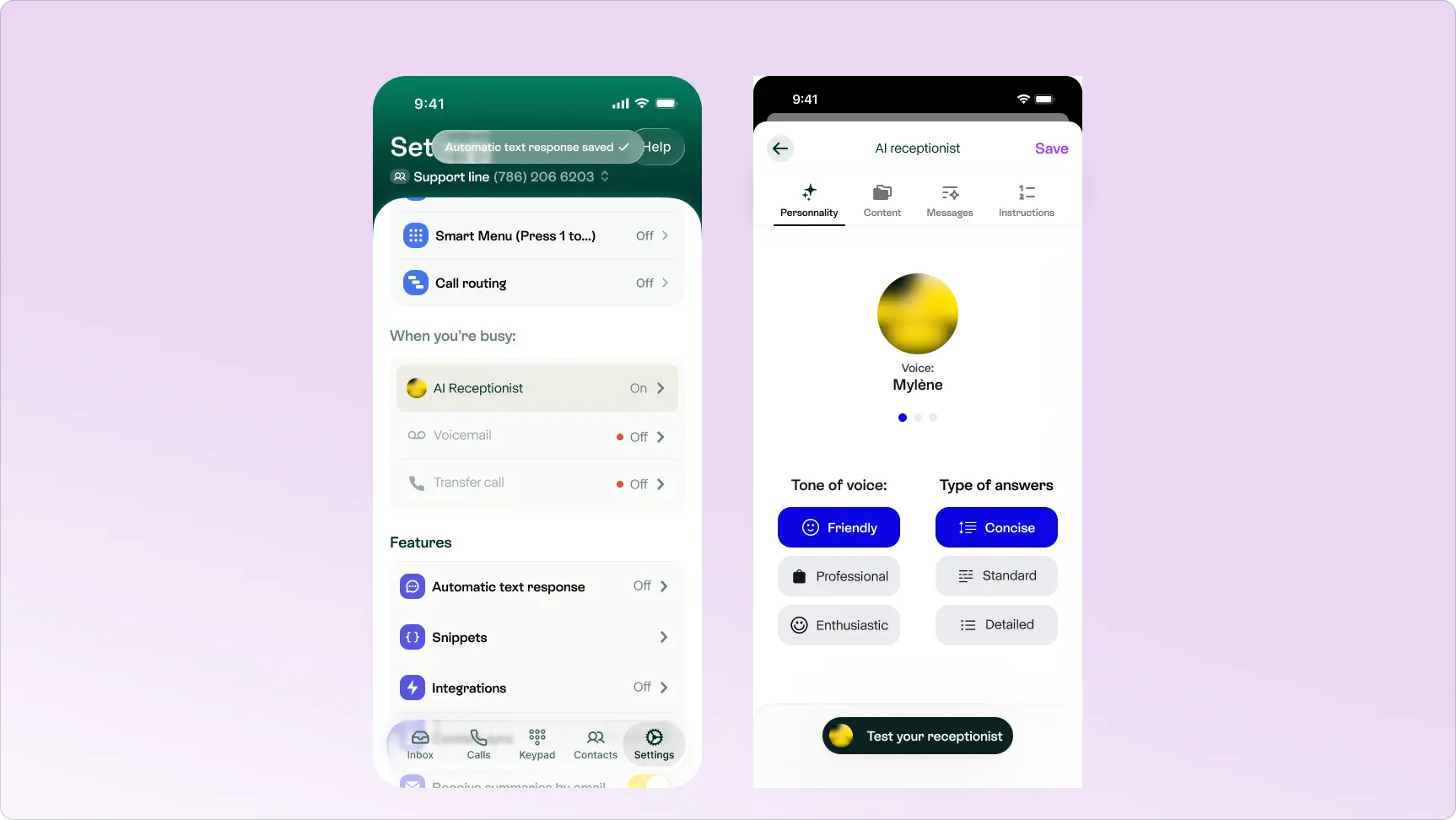HubSpot needs no introduction — it’s only one of the world’s most popular CRMs, after all. But did you know that some HubSpot accounts support calling and texting? That way, you can easily message customers and contacts right from your CRM.
But is HubSpot Calling all it’s cracked up to be? If you look a little closer, you might see, well, a few cracks. Read reviews from the sales reps and service agents who deal with customer interactions every day, and you might see “It's so bad [you may] have to stop using HubSpot.”
The good news is, HubSpot easily integrates with business phone systems. That way, you can automatically log contacts across all your business tools. We’ve listed seven of the best VoIP systems for you to consider — plus their prices, features, and pros/cons — so you can make informed decisions.
Article overview
- Most small and growing businesses need separate VoIP software for HubSpot because of its lack of call quality, limited features, and high costs.
- The seven best VoIP providers that integrate with HubSpot are Allo, Aircall, RingCentral, Zoom Phone, Dialpad, Quo (formerly OpenPhone), and Vonage.
- Allo is the best phone system for sales teams wanting to close more deals, faster.
Benefits of Using a Third-Party Call App With HubSpot
HubSpot’s native VoIP system — HubSpot Calling — lets you log calls and texts directly in your HS CRM. You can also download the HubSpot mobile app to make calls and send texts from your desktop, laptop, or cell phone.
HubSpot Calling is available within the Sales Hub and Service Hub plans, as well as the Customer Platform bundles at corresponding tiers. Marketing, Commerce, Data, and Content Hub plans do not include calling features natively.
HubSpot Calling is available on these plans for the following price range:
But as you might have already discovered, HubSpot Calling isn’t necessarily what you’d call ‘intuitive.’ It can be a bit unwieldy to manage inbound calls, and depending on your HubSpot account, managing a HubSpot number could be expensive and generally unreliable.
Between the poor call quality, arbitrary limits, and expensive automations, HubSpot Calling rarely makes sense for teams wanting to scale their customer support.
No need to take our word for it, though.
Let’s take a closer look.
Poor Call Quality
Ask anyone who’s used the HubSpot dialer before, and they’ll likely tell you the quality leaves much to be desired.
That’s because HubSpot still uses Twilio — a legacy tool that enables Voice over Internet Protocol, or VoIP — to power calls. Unfortunately, Twilio doesn’t support HD voice. This can result in frustrating problems that affect your entire team.
Past users have referenced call quality issues like jitter, latency, and dropped calls. Some users say it affects inbound calls and outbound calls, regardless of whether they use HubSpot Calling’s mobile or desktop app.
You don’t need to be a rocket scientist to know that poor call quality can create a negative customer experience. It may also lead to missed calls, aka, lost revenue. Plus, it can affect your sales reps’ ability to close more deals per day.
See for yourself:
“I have a serious problem with the quality of HubSpot calls. Its so bad that I have to stop using HubSpot as I have been told many times that the call quality is bad and that I am breaking up. This is massively affecting my job. I have tried different browsers and different headsets, wired and wireless broadband in differnt locations and still I have poor quality. The issue is making Hubspot unusuable. I was 1 day into the term and on the second day I knew it was going to be a major issue which is when I first escalated the issue with HubSpot support.” — HubSpot Support
Limited Features
HubSpot Calling offers a few bells and whistles, like call recording, call transcriptions, call monitoring, and call queueing. Unfortunately, all of these (other than call recording) are locked behind Professional and Enterprise plans.
And the features you do get pale in comparison to the features you don’t.
For example:
- Calling is only available in specific countries, some of them with significant limitations.
- You can’t make any calls from a Safari browser.
- HubSpot’s caller ID may not work on Android devices, which could make your phone numbers look “fishy” to potential prospects.
- You can’t have more than five phone numbers at once. If you want to manage six HubSpot-provided phone numbers at once, you’ll need to spend an extra $25 per month for five extra ‘slots.’
- According to HubSpot, “Toll-free numbers are not supported as HubSpot provided phone numbers.” This means there’s no way to purchase a new toll-free number on the phone numbers tab — you’ll have to port in a number from another VoIP provider.
The cherry on top? Even your minutes are limited.
We’ll look closer at this in the section below.
No Unlimited Minutes or SMS
Most business phone systems let you make unlimited calls in the US and Canada. HubSpot, however, does not.
Your HubSpot-provided phone number and minutes are limited by your subscription tier. They’re also pooled among everyone on our account. That means everyone on your team will need to share whatever credits you have.
Here are HubSpot Calling’s minute limits according to your plan:
- Starter Tier Plans: One phone number; 500 minutes of calling per account per month
- Professional Tier Plans: Three phone numbers; 3,000 minutes of calling per account per month
- Enterprise Tier Plans: Five phone numbers; 12,000 minutes of calling per account per month
And as you might imagine, it won’t take long for your sales and support teams to use up 500 minutes of calling collectively.
Think you can mix and match plans to get around this? No dice: you can’t combine multiple hubs (like Sales Hub Professional and Service Hub Professional) to get up to 6,000 minutes per month. You’re limited to your plan’s max limit — so on a Professional tier, that’s 3,000 minutes of calling per account per month.
If you want more minutes than what your plan allows, you’ll have to purchase more minutes. But you can only purchase extras if you’re on a Sales Hub or Service Hub Professional or Enterprise plan.
It costs $50 extra per account per month to increase your calling minute limit by 1,000 minutes. This comes out to roughly 16 hours and 45 minutes of calling time per month. And yes, minutes count for both inbound and outbound calls.
You should also keep in mind that unused minutes don’t roll over. So if you purchase a minutes pack and don’t use every credit, you’re technically losing money.
Similarly, if you want to send SMS or MMS through HubSpot Calling, you’ll need to purchase some pricey add-ons.
It costs $75 per number per month for a 10-digit DLC number that only sends (and receives) messages from US and Canada numbers. But you only get 1,000 message segments per month, which apply to incoming and outgoing messages. MMS messages require five segments each. That means you technically only get 500 SMS messages per month, or 200 MMS messages per month, if the customer responds.
Need to send more SMS messages per month? Strap in for some costly fees. It’s $15 per month for every additional 1,000 segments, on top of other fees that scale up as you grow.
Another gut punch: unused message segments don’t roll over into the following month. That means even if you only use 600 message segments in a month, you lose the other 400 segments you don’t use. That’s a waste of ~$30 in unused minutes.
The good news is, HubSpot Calling is the exception rather than the rule. Compare it to business phone systems like Allo, which lets you receive unlimited SMS messages on every plan.
Expensive Automations and AI Features
The HubSpot dialer does come with automations and artificial intelligence tools — but only if you’re willing to pay for them.
For example, HubSpot does not currently offer an AI receptionist.
You may also need to purchase add-ons for features like:
- HubSpot Workflows to help enter data, ranging from $200 to $1,000 per month
- Marketing SMS short codes, starting at $1,500 per month
- Additional transcription hours, starting at $250 per month
Even conversation intelligence, HubSpot’s AI tool for coaching and performance, is trapped behind Professional and Enterprise-level plans. This means you’ll likely end up paying around $800 per month or more just to access features typically available on most companies’ base plans.
We’ll let this review speak for itself:
“So many features hidden behind exorbitant paywalls.” — Reddit
It’s clear the HubSpot dialer isn’t the best calling solution for most sales, service, and customer support processes. But the good news is, it’s not your only option.
We’ve collected seven of the best HubSpot phone integrations you can use for building relationships, closing deals, and empowering sales and support agents.
Why you can trust our selection
We rounded up and ranked the best HubSpot phone integrations using a three-step process.
First, we gathered up all business phone systems listed on HubSpot’s App Marketplace. Then, we assessed each platform based on features, user reviews, and usability.
Finally, we took a deep dive into each platform to determine whether or not they “passed the smell test.”
This test was proctored via these three factors:
- Pricing: How cost-effective is the integration?
- Automations: Does it offer more than HubSpot’s basic tools?
- Features: Outside of HubSpot call logging, what else can your phone system do?
Below is the list of remaining platforms that matched or exceeded our standards.
1. Allo: Best for Growing Sales Teams
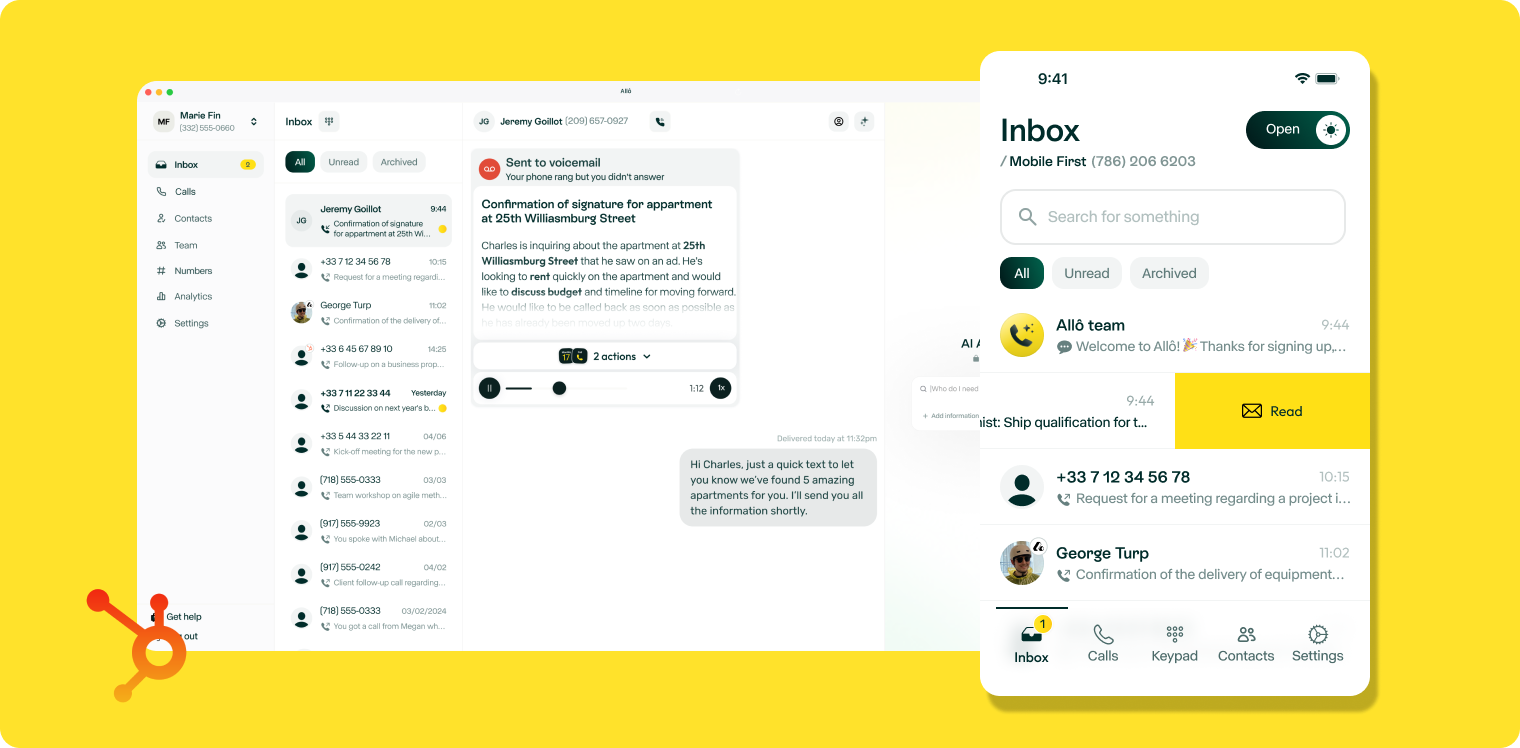
- Pricing: Starts at $32/user/month
- Installations: 200+
- Rating: 5/5 from 3 reviews
Allo is a modern AI-powered phone system that offers unlimited calling and texting in the US and Canada. Unlike HubSpot Calling, you won’t need to pay extra for inbound and outbound minutes. Plus, our Business Plan offers unlimited SMS and MMS messages per month. No more purchasing add-ons for extra minutes and credits.
You can use the Allo/HubSpot integration to map every step of your customer’s journey. Track every caller’s deal stage, company name, and contact records, then store them within Allo. Plus, every Allo call is logged inside your HubSpot CRM. You’ll have a single source of information for all your caller data.
Speaking of data, Allo can help you retrieve info fast with real-time customer details that pop up during calls. This makes it easier for your team to reference past interactions and respond exactly how your caller needs and expects.
Don’t want to forget important details? Save and review every conversation by turning on automatic call recording. Then, use our AI-generated call summaries to quickly skim through other details for future reference.
With Allo, you’ll also have access to modern business features like:
- Smart call routing with business hours and IVR
- An AI Receptionist that handles incoming calls 24/7, 365
- An AI Assistant that reads your call transcripts, history, and notes to answer questions you ask about your customers, deals, and next steps
- Auto-replies, which respond via text to missed calls
Take Allo on a spin for yourself by signing up for a seven-day free trial.
Allo’s Business Plan + HubSpot Integration Features
- Automatically log Allo activity in your HubSpot CRM
- Sync companies, deals, and contact records
- Supports HubSpot’s mobile and desktop app
- Real-time customer details during calls
- Other tools such as AI call insights
- International calls to 110+ countries
- Call summaries
- Unlimited AI receptionist
- Forward inbound calls
- Contact updates
How to Connect HubSpot to Allo
You can connect Allo and HubSpot in four easy steps:
- Open the Allo app on your phone.
- Under Account → Integrations, select HubSpot.

- Choose which HubSpot account you wish to connect.
- Tap the button toggle to activate Allo call syncing in HubSpot.

And that’s in! With Allo, you’re now ready to automatically log recording calls, call activity, and call details in HubSpot.
Pros & Cons of Allo
2. Aircall: Best for Customer Support Centers

- Pricing: Starts at $90/month (three-user minimum required)
- Installations: 4,000+
- Rating: 4.3/5 from 311 reviews
Aircall is a cloud-based business phone service designed to support international contact centers. It offers all the popular VoIP software features you might expect — think unlimited calling, texting, and IVR — plus global features for businesses expanding internationally. For example, you can purchase international numbers in more than 100 countries.
Once you connect Aircall with HubSpot, you can start placing calls directly from the HubSpot app. Plus, you can automatically log every interaction and route inbound calls based on CRM data. It’s one of the only third-party phone systems that connects with the HubSpot HelpDesk, which is invaluable if your team is already using that ecosystem.
But even with all these benefits, there are some tradeoffs to keep in mind.
For starters, the base Aircall plan requires at least three users, which means you’re paying $90 per month (not $30 per user per month) just to access the phone system. Then, you must unlock the ability to log calls in your CRM. This requires the AI Assist plan, which requires another $9 per license per month. The total cost of integrating Aircall with HubSpot comes out to around $117 per month.
Keep in mind that these two features don’t work together on the same integration. In fact, there are two separate Aircall apps available in HubSpot — one for calling, and one for syncing data. This can be clunky for fast-growing teams that just want a lean and uncomplicated tech stack.
Want other options? Learn more about eight strong alternatives to Aircall.
Aircall’s HubSpot Integration Features
- Aircall Powerdialer
- International numbers
- Syncing data (requires a separate integration and add-on)
- International calling and messaging
- Integrates with HubSpot HelpDesk
Pros & Cons of Aircall
3. RingCentral: Best for Analyzing Team Metrics

- Pricing: Starts at $20/user/month
- Installations: 7,000+
- Rating: 2.5/5 from 80 reviews
RingCentral is a unified communications company, meaning it combines calls, texts, and video conferencing into the same tool. There are lots of separate plans available for small businesses, contact centers, event managers, and even conversation intelligence tools. So it’s no wonder there are so many integrations in the HubSpot App Marketplace: four, to be exact. But for our purposes here, we’re focusing on the RingEX by RingCentral integration.
RingCentralxHubSpot adds an extra layer of insight by syncing disposition data into one place. Plus, teams can click-to-call directly from contact records, automatically log calls, review notes, and view activity across both platforms. If you’re willing to pay extra for RingCentral’s AI Assistant, you can also generate summaries or highlight key moments from calls.
But as you can see, most of RingCentral’s best features are locked behind separate integrations. Plus, not all of them are available from a single plan. This can get confusing and expensive fast.
You should also know that RingCentral as a platform comes with multiple (read: unnecessary) baked-in limitations. For example, there are limits on how many toll-free minutes, SMS messages, and call recordings you can keep. This could catch teams off guard if they’re accustomed to more generous allotments elsewhere. And, interestingly, sounds very much like HubSpot Calling.
Keep in mind the RingEX/HubSpot integration may also suffer from recurring technical problems. With a rating of 2.5/5, it’s clear most users have been dissatisfied.
RingCentral’s HubSpot Integration Features
- Call dispositioning
- Association call logging
- Contact syncing (requires additional integration)
- RingCentral AI Assistant
Pros & Cons of RingCentral
4. Zoom Phone: Best for Zoom Ecosystem Users

- Pricing: Starts at $15/user/month (free plan also supported)
- Installations: 4,000+
- Rating: 1.9/5 from 73 reviews
Zoom Phone is the VoIP arm of Zoom Communications, which you probably recognize as “that video meeting company.” With its HubSpot integration, you can seamlessly sync content data between platforms, click to dial inside the platform, and send and receive texts without using your HubSpot credits.
Keep in mind you need a Zoom Phone license to get started, plus the app installed on your desktop or smartphone. Also, iPad support for dialing via the HubSpot integration is no longer available.
Zoom Phone doesn’t necessarily offer more utility than HubSpot Calling per se, but it does make sense if you’re already embedded in the Zoom ecosystem. Just keep in mind you can’t make video calls with the Zoom Phone/HubSpot phone integration. For that, you’ll need a separate Zoom integration.
Don’t want to juggle multiple integrations? You may want to explore a Zoom Phone alternative.
Zoom Phone’s HubSpot Integration Features
- Click to dial
- Automatic syncing
- Send and receive texts
- Leave call notes for other agents
- Nest voicemails and recordings
Pros & Cons of Zoom Phone
5. Dialpad: Best for Automated Follow-Ups

- Pricing: Starts at $75/month (three-user minimum)
- Installations: 4,000+
- Rating: 3.8/5 from 203 reviews
Dialpad is a cloud-based business phone system built around one big promise: letting AI handle the tedious parts of calling. Connecting Dialpad with HubSpot comes with basic features like click-to-call and content syncing. However, you can also tap into tools like automated follow-ups and instant ticket creation for your team.
In fact, Dialpad’s reporting tools can be more accessible (and affordable) than HubSpot’s. With the Dialpad/HubSpot integration, you can receive call summaries, action items, CSAT signals, and outcome tags. This helps teams paint a clearer picture of what’s happening inside conversations. If your support or sales reps live in follow-ups, it’s one of the more helpful tools on this list.
But beware: the cost of Dialpad’s HubSpot integration can add up fast. For starters, it requires the Pro plan, which requires at least three users (and caps out at ten). This means you’ll be paying $75 per month, not $25 per user per month. Even for the price, you won’t have access to all the integration’s best features. Key reliability tools — like 99.9% uptime — require yet another upgrade.
And keep in mind that some users report contact syncing issues between Dialpad and your HubSpot account. This can be frustrating if you rely on clean CRM data before making any outgoing calls.
Love the idea of reporting and AI tools without Dialpad’s limitations? Check out our guide to Dialpad alternatives.
Dialpad’s HubSpot Integration Features
- Automated follow-ups and ticketing
- Click to call within HubSpot
- SMS logging
- AI-powered insights (action items, summaries, CSAT scores, purpose, and outcomes)
- Automatic contact logging in Dialpad
Pros & Cons of Dialpad
6. Quo (formerly OpenPhone): Best for Service-Based Businesses

- Pricing: Starts at $23/user/month
- Installations: 4,000+
- Rating: 3.4/5 from 59 reviews
Quo, formerly OpenPhone, is a VoIP platform that lets you create and sync contacts within your phone system to HubSpot. It offers local and toll-free numbers, which is something you can’t get with a HubSpot-provided phone number alone. Plus, you can connect with webhooks to set up more customized data flows.
You can also rely on Quo to access more automations and reporting features (at better prices) than HubSpot. Along with automatic call recording, you get AI call summaries and transcripts, plus a dedicated calling tab that lists information related to your customers.
But you should know that Quo isn’t a fully featured integration, meaning that much of its call data only moves one way. For example, you can create contacts inside of HubSpot and send them to Quo, but not the other way around. You also can’t call customers from HubSpot using Quo — which might be a dealbreaker for teams wanting better click-to-dial integrations.
Last but not least, user reviews highlight problems and bugs with the integration. There is technical support available if you need help, but keep in mind you might not be a priority unless you’re on a more expensive plan.
Quo’s HubSpot Integration Features
- Automatic call logging
- AI call summaries and transcripts
- Automatic call recording
- Sync contacts from HubSpot to Quo
Pros & Cons of Quo
7. Vonage: Best for Technical Users
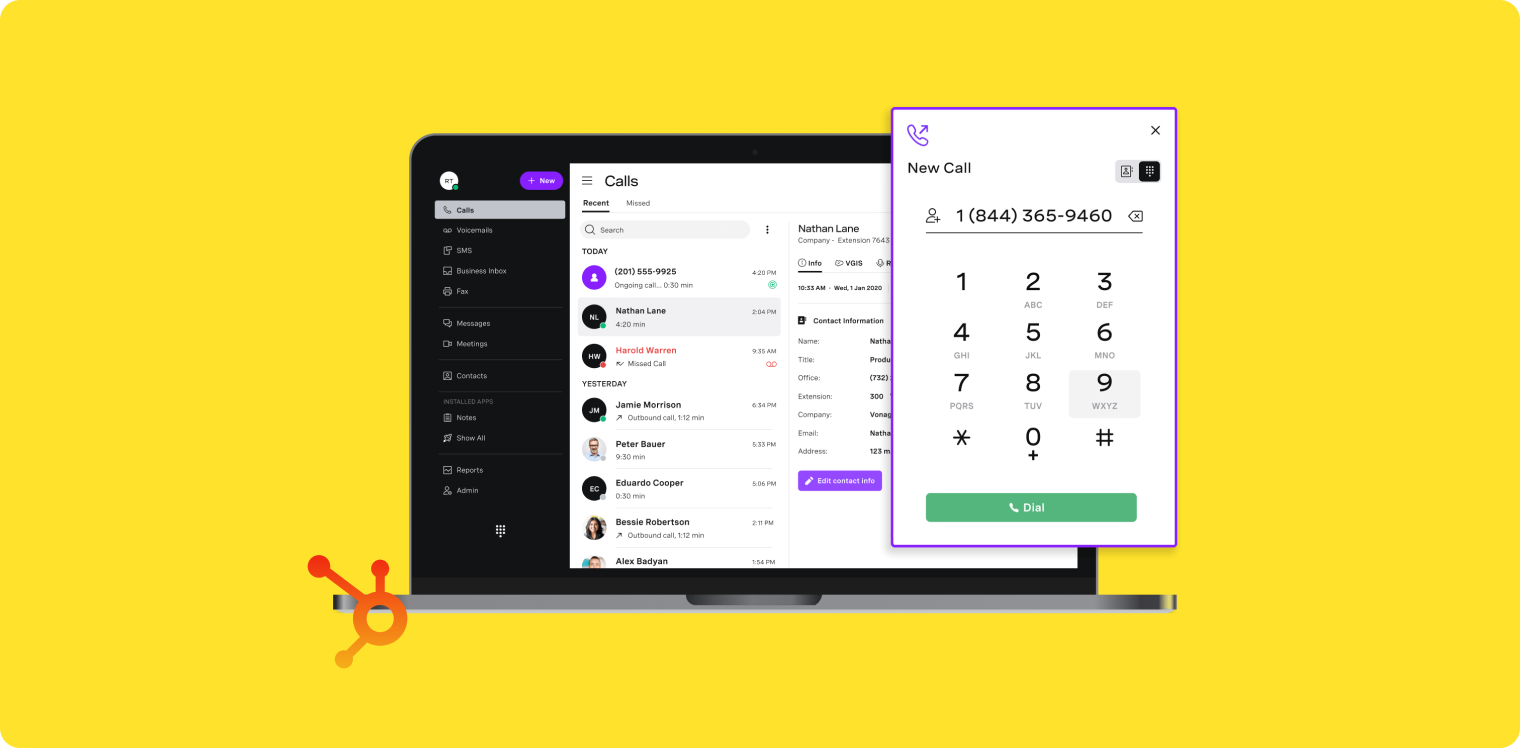
- Pricing: Starts at $20.99/user/month
- Installations: 900+
- Rating: 1.4/5 from 19 reviews
Vonage is a legacy communications platform that offers voice, messaging, and video tools to small businesses. Its Business Communications plans integrate with HubSpot Calling to help automatically log phone calls and messages in your existing phone platform.
One benefit to Vonage is that it comes with APIs, which makes it perfect for technical users who want to curate the perfect business tech stack. It also offers a simple information retrieval system. Vonage’s HubSpot interaction helps identify callers and pulls their data up so it's immediately in front of whoever’s taking a call.
But Vonage’s HubSpot dialer integration isn’t what you’d call ‘simple.’ Admin users will need to learn how to use the Vonage Integration Suite (VGIS), which for non-technical people, could be extremely intimidating. You’ll also need to ‘request’ the app before it shows up on your desktop and mobile app. That means, if your VBC Administrator doesn’t move quickly, it might take a while to set up your Vonage/HubSpot integration.
“I have spent 4+ hours trying to integrate our sales team. To date this is still not complete. Links from request are not connected or result in an error message. How difficult can this be? I asked that all sales staff be connected. Do I really have to do a ticket to get this processed for each person?” — HubSpot Marketplace
Even when you do set up your integration, keep in mind the UX may not be easy to use. Many past users report a clunky, unintuitive widget that makes it harder to navigate HubSpot’s records.
Vonage’s HubSpot Integration Features
- Click-to-call widget
- Capture call notes
- Call tagging
- Call reporting
- Log call information
- Create HubSpot contacts from Vonage
- Screen pops with relevant customer data
- Real-time inbound and outbound call statistics
Pros & Cons of Vonage
Frequently Asked Questions HubSpot Phone Integrations
[[faq-blog]]
Does HubSpot have a phone dialer?
HubSpot does have a native phone dialer called HubSpot Calling. But keep in mind it’s only available on specific plans, comes with many limitations, and is expensive compared to modern business phone services like Allo.
Can I receive calls in HubSpot?
You can receive calls in HubSpot in one of two ways: through a HubSpot-provided number via the native HubSpot Calling tool, or through a third-party business phone system such as Allo. Most growing businesses find it easier to start with third-party phone providers since they typically offer more features and a higher-quality calling experience.
How much does HubSpot phone cost?
HubSpot’s phone system starts at $9 to $15/user/month on Starter Service, Sales Hub, and Customer Service plans. If you upgrade to Professional tier plans, you’ll get other features for $150/user/month. The Enterprise Customer Platform is the most expensive option at $4,700 per month.
How do I connect my phone to HubSpot?
If you're using HubSpot calling, open the HubSpot mobile app, sign in, and follow the prompts to connect your phone. You can enable calling, contacts, and notifications from the app settings. If you're trying to track calls or texts, just turn on the calling and contact permissions so HubSpot can sync activity automatically.
For third-party VoIP providers, connect them through HubSpot’s Calling Integrations. Go to Settings → Calling → Connect a Calling Provider, choose your VoIP service from the list, and follow the provider’s authentication steps.
What phone systems integrate with HubSpot?
Some phone systems that integrate with HubSpot include:
- Allo
- Aircall
- RingCentral
- Zoom Phone
- Dialpad
- Quo (Formerly OpenPhone)
- Vonage




